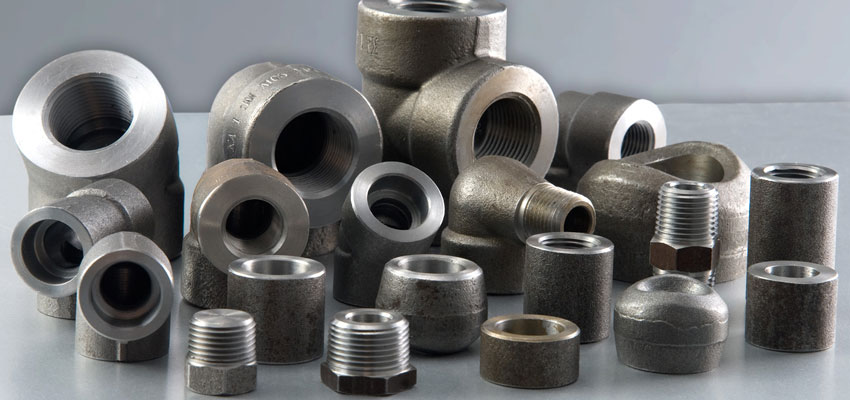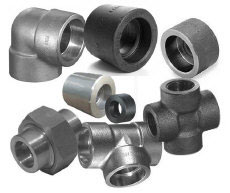Contact : +91-79045 61980 | Email: hydrofitengineers@gmail.com




SOCKET WELD PIPE FITTINGS
Socket weld pipe fittings are components used to connect pipes in a piping system. They are designed for high-pressure applications where a secure and leak-proof connection is essential. Socket weld fittings have a socket or recessed area at one end where the pipe is inserted and welded, creating a strong joint
Types of Socket Weld Fittings
- Socket Weld Elbow: Used to change the direction of flow in a piping system. Elbows are available in various angles, such as 45 degrees or 90 degrees, to accommodate different piping configurations.
- Socket Weld Tee: Used to split or combine the flow in a piping system. Tees have three openings, with one inlet and two outlets at 90-degree angles to the main pipe.
- Socket Weld Coupling: Used to connect two pipes of the same diameter in a straight line. Couplings consist of two parts that fit together and are welded to the pipes, providing a secure connection.
- Socket Weld Union: Similar to a coupling but provides the ability to easily disconnect and reconnect pipes. Unions consist of three parts: a male end, a female end, and a nut that screws the two ends together.
- Socket Weld Cap: Used to close the end of a pipe. Caps are welded onto the pipe end to seal it securely, preventing the leakage of fluids or gases.
- Socket Weld Reducer: Used to connect pipes of different diameters. Reducers typically have one end smaller than the other to facilitate the transition between pipe sizes, maintaining the flow rate in the piping system.
These fittings are available in various materials, such as stainless steel, carbon steel, alloy steel, brass, and other metals or alloys, depending on the specific requirements of the application. They are commonly used in industries such as oil and gas, chemical processing, power generation, shipbuilding, and many others, where high-pressure and high-temperature conditions are prevalent. Proper welding techniques and procedures are essential to ensure the integrity and strength of the socket weld joint.
Salient Features of Socket Weld Pipe fittings
Socket weld pipe fittings offer several salient features that make them suitable for various industrial applications
- High Pressure Capability: Socket weld fittings are designed to withstand high-pressure environments, making them ideal for applications where fluid or gas pressure is a concern.
- Leak-proof Seal: The socket weld joint creates a strong and leak-proof seal between the pipe and the fitting, ensuring the integrity of the piping system.
- Compact Design: Socket weld fittings have a compact design, making them suitable for use in tight spaces or areas where a full-sized flange fitting might be impractical.
- Smooth Flow: The smooth interior surface of socket weld fittings minimizes turbulence and pressure drop in the piping system, promoting efficient fluid or gas flow.
- Resistance to Vibration: Socket weld joints provide excellent resistance to vibration and mechanical stress, reducing the risk of joint failure in dynamic operating conditions.
- Ease of Installation: Socket weld fittings are relatively easy to install compared to threaded or flanged fittings, requiring minimal preparation and welding equipment.
- Corrosion Resistance: Socket weld fittings are available in a variety of materials, including stainless steel, carbon steel, and alloy steel, offering excellent corrosion resistance properties suitable for harsh environments.
- Versatility: Socket weld fittings come in a wide range of configurations, including elbows, tees, couplings, unions, caps, and reducers, providing flexibility in designing and constructing piping systems to meet specific requirements.
- Permanent Connection: Once welded, socket weld fittings create a permanent connection between the pipe and the fitting, ensuring long-term reliability and durability of the piping system.
- Cost-Effective: Despite their robust construction and high-performance capabilities, socket weld fittings are often cost-effective solutions for piping systems, offering value in terms of reliability and longevity.
These features collectively make socket weld pipe fittings a preferred choice for many industrial applications where high pressure, tight sealing, and reliability are paramount
Design and Construction of Socket Weld Pipe fittings
The design and construction of socket weld pipe fittings are crucial aspects that determine their performance, reliability, and suitability for various applications. Here’s an overview of the typical design and construction characteristics of socket weld pipe fittings:
- Materials:
- Socket weld fittings are commonly made from materials such as stainless steel, carbon steel, alloy steel, brass, and various other metals or alloys.
- The material selection depends on factors such as the operating conditions (pressure, temperature, corrosiveness), compatibility with the fluid or gas being transported, and regulatory requirements.
- Manufacturing Process:
- Socket weld fittings are typically manufactured through forging, machining, or casting processes.
- Forged fittings are commonly preferred due to their superior strength, integrity, and resistance to fatigue and impact.
- Machining and casting processes are also utilized for certain applications, providing cost-effective solutions for less demanding environments.
- Socket Design:
- The socket portion of the fitting is designed to accommodate the pipe end for welding.
- It features a cylindrical interior with a slight taper to facilitate insertion of the pipe and ensure proper alignment during welding.
- The socket depth is designed to allow sufficient penetration of the pipe into the fitting for a strong weld joint.
- Welding Preparation:
- Prior to welding, the pipe end and the interior surface of the socket are thoroughly cleaned and prepared to ensure proper fusion and bonding.
- The pipe end may be beveled to facilitate weld penetration and create a smooth transition between the pipe and the fitting.
- Welding Process:
- Socket weld fittings are welded to the pipe using a fillet weld around the perimeter of the joint.
- The welding process typically involves preheating the fitting and the pipe to prevent thermal stress and ensure uniform heating during welding.
- Shielding gases or fluxes may be used to protect the weld pool from oxidation and contamination.
- Dimensional Standards:
- Socket weld fittings are manufactured to industry standards such as ASME B16.11 (for forged fittings) and ASTM A182 (for materials specification).
- These standards define dimensional requirements, tolerances, materials, and marking specifications to ensure interchangeability and compatibility between fittings from different manufacturers.
- Quality Control:
- Socket weld fittings undergo rigorous quality control measures to ensure compliance with specifications and standards.
- This includes dimensional inspections, material testing, weld quality assessments, and surface finish examinations.
Overall, the design and construction of socket weld pipe fittings are meticulously engineered to meet the demanding requirements of high-pressure piping systems while ensuring reliability, longevity, and safety. Proper material selection, manufacturing processes, welding techniques, and quality control measures are essential to achieving optimal performance and functionality in various industrial applications.
Applications of Socket Weld Pipe Fittings
Oil and Gas Industry
Socket weld fittings are extensively used in oil and gas exploration, production, refining, and transportation facilities. They are employed in pipelines, refineries, petrochemical plants, and offshore platforms where high-pressure and corrosive environments are prevalent.
Chemical Processing
In chemical plants and facilities, socket weld fittings are utilized for conveying corrosive chemicals, acids, and solvents. Their resistance to corrosion and ability to withstand high pressures make them suitable for handling hazardous substances.
Power Generation
Socket weld fittings are employed in power plants, including nuclear, fossil fuel, and renewable energy facilities. They are used in piping systems for steam, water, and other fluids at high temperatures and pressures
Ship Building and Marine Applications
Socket weld fittings are commonly used in shipbuilding and marine industries for various piping systems on vessels, offshore platforms, and maritime structures. Their compact design and resistance to vibration make them ideal for marine environments.
Aerospace and Defence
In aerospace and defense applications, socket weld fittings are used in hydraulic systems, fuel lines, and other critical fluid-handling systems where reliability and performance are paramount
Food and Beverage Industry
Socket weld fittings are employed in food processing plants and beverage manufacturing facilities for sanitary piping systems. They are used to convey food-grade fluids and comply with strict hygiene standards.
Pharmaceutical Industry
In pharmaceutical manufacturing, socket weld fittings are used in piping systems for conveying pharmaceutical products, sterile fluids, and gases. They meet stringent regulatory requirements for cleanliness and product purity
Water Treatment and Distribution
Socket weld fittings are used in water treatment plants, municipal water distribution networks, and wastewater treatment facilities. They are employed in piping systems for conveying potable water, chemicals, and wastewater
HVAC (Heating, Ventilation, and Air Conditioning)
Socket weld fittings find application in HVAC systems for commercial buildings, industrial facilities, and residential complexes. They are used in piping systems for heating, cooling, and ventilation.
General Industrial Applications
Socket weld fittings are utilized in various other industrial sectors, including pulp and paper, mining, textiles, automotive manufacturing, and construction. They are employed in piping systems for conveying fluids, gases, and steam in diverse applications.
Overall, socket weld pipe fittings are versatile components that play a critical role in numerous industrial sectors, ensuring the efficient, reliable, and safe operation of piping systems in demanding environments
